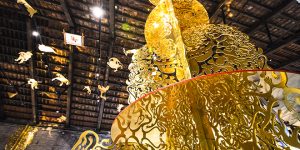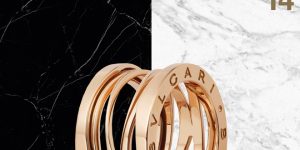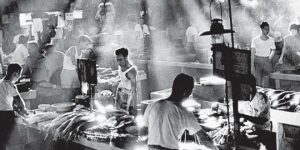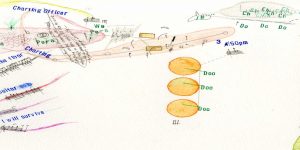‘SerpentiForm: Snake Through Art, Jewellery and Design’ exhibition at ArtScience Museum, Singapore
Bulgari explores the symbolism of its most iconic motif: the serpent

Serpenti belt in gold with black enamel and diamonds, 2010. Bulgari Heritage Collection
Good and evil, poison and fertility, tempter and protector, immortality and death, knowledge and deceptor: few creatures bear as many symbolic dualities as the serpent, whose ability to shed its skin and emerge renewed has, for centuries, mesmerised and terrorised humans. But its inherent mystery is steeped in more than religious, mythical and historical references, as you’ll discover in Bulgari’s experimentations with the serpent as a symbol of power, rebirth and seduction.
When ‘SerpentiForm: Snake Through Art, Jewellery and Design’ opens to the public at the ArtScience Museum in Singapore on 19 August, expect a collection of 56 Bulgari creations that pay tribute to the motif now synonymous with the luxury goods and jewellery house, including four never-before-seen pieces. Alongside are 15 antiquities from East and West, 74 artworks and 21 dresses tracing antiquity through modern times, each offering glimpses of modern and contemporary art, design, fashion, decorative arts and photography that have been inspired by the snake in all its loved or loathed glory.

Peter Hujar, ‘Skippy on a Chair (I)’, 1985. Image courtesy The Peter Hujar Archive, LLC, Pace/MacGill Gallery, New York and Fraenkel Gallery, San Francisco.
Explains Bulgari Brand and Heritage Curator, Lucia Boscaini, “‘SerpentiForm’ is meant to convey the timelessness of the powerful serpent motif between present and past [as well as] the universal and multifaceted presence of the serpent in all cultures. In Italy, for example, it is the symbol of Pharmacy as a token of healing and, in the biblical Adam and Eve story, a metaphor for sin and temptation.” Along with a team of eight, Boscaini works with the Maison’s Brand Heritage Department on each Bulgari-themed exhibition for up to two years.
Notably, the serpent only began gliding into Bulgari pieces in the late 1940s, or roughly a century after the brand’s inception in 1844. Its bejewelled, coiling body in form of bracelet-watches marked the birth of Serpenti, a centuries-old mainstay that has both paved the way for variations of the original timepiece and landed itself a well-loved place on the wrists of collectors the world over.

Serpenti bracelet-watch in gold with polychrome enamel and emeralds, 1967. Bulgari Heritage Collection.
“To Bulgari, the snake’s livery is a field of unceasing experimentation. I wanted to show how [the exhibition] could be transversely stimulating,” says Boscaini. Unlike the 2016 showing of ‘Serpentiform’ in Rome, the Singapore edition is “on a much larger scale in terms of number of exhibits and scope, and the appearance of the serpent in myths and legends is much more explored, with an increased presence of Eastern artists, antiquities and artworks.”
The exhibition opens with an examination of the symbolic meanings of snakes in myths and legends through precious antiquities from East and West: think apotropaic snake jewels from Ancient Rome, a statue of a young Hercules strangling snakes from 2nd century AD and, from 4th century BC, pieces that show off the creature’s ties to menace and protection. Delving into systems of faith and worship, admire an early 12th century Buddha protected by a Naga snake – or, in quite the juxtaposition, Chinese statues that depict divinities protecting tombs from snakes from 2nd to 6th century AD.
Maintaining the motif of the serpent as a stronghold in modern and contemporary art, the works of Joan Miró, Marc Chagall, Alexander Calder, Keith Haring, Niki de Saint Phalle, Joana Vasconcelos and Heri Dono feature alongside those of Robert Mapplethorpe and Helmut Newton, themselves masters of photography. Each piece offers representations of the creature in a multifaceted journey that, notes Boscaini, will take visitors through the “more stylised or playful representation of the serpent [and its] more realistic or evocative approaches.”

Heri Dono’s ‘A snake’s player’, 2016. Image courtesy Mizuma Gallery.
And, in a display of the serpent as an ambivalent weapon that is at once playful and fascinating, visitors can even take on the role of artists through a digital experience, in which customisable Bulgari Serpenti pieces will be projected within the exhibition space. An augmented reality experience will also reveal a ‘hidden serpent’ artwork, shares Boscaini. To add to the experience, “we took over the exhibition space with dedicated music in different areas, and a Bulgari fragrance diffused in selected rooms to accompany the exhibits in a truly immersive way.”
But a draw for many would be the extensive display of Bulgari Serpenti creations from the Maison archives and private collections that date as far back as 1950. The latter piece in question – a gold bracelet set with ruby and diamonds – joins yet other stylised early models made with the Tubogas technique, a style derived from the Roman times in which gold strips are tightly interlocked to form a flexible body such that no soldering is required. Alongside are more realistic pieces enamelled in a spectrum of colours, or finished with gold scales and emeralds – each of which reflects a slice of the serpent’s many connotations through time.

Serpenti bracelet in gold with jade, rubies and diamonds, 1965. Bulgari Heritage Collection.
More information at bulgari.com/en-us/serpentiform-exhibition-singapore.
This article was written by Rebecca Liew for Art Republik













